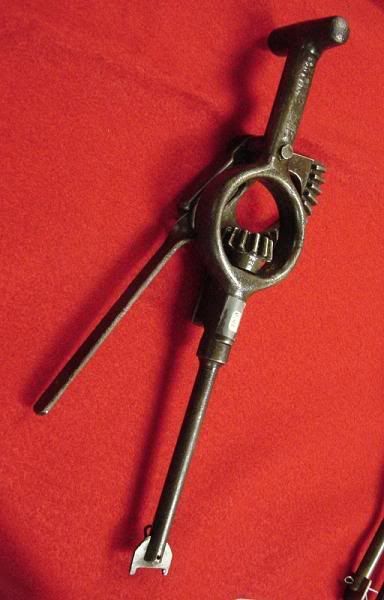Set 202
1115. 7" long:

Larger image
1116. 8" long, from the 1860's, more guesses on this device can be found at Neatorama:


Larger image
1117. 10" long:

-Parts A, B, and C are connected and move as one piece.
-Part D is connected to handle 1, see second photo.
-To operate, hold handle 1 with the right hand, and turn handle 2 with the left, 2 will make contact with A, causing shaft C to rotate, handle 2 will next strike B, rotating C in the opposite direction.
-Continuous turning of the handle results in a back and forth rotation of shaft C.
Larger image


1118. 12" long:

Larger image


Larger image
1119. 6-1/2" long:

When the handles are fully compressed there is a 1/4" gap between the jaws, they are 5/8" apart in this photo.
1120. 9-1/2" long:

1121. 6" long, submitted by a visitor:

-----
To submit photos, click on the profile link at the upper right to find my email address.
Answers
Last week's set is seen below, click here to view the entire post:

More discussion and comments on these photos can be found at the newsgroup rec.puzzles.

Larger image
1116. 8" long, from the 1860's, more guesses on this device can be found at Neatorama:


Larger image
1117. 10" long:

-Parts A, B, and C are connected and move as one piece.
-Part D is connected to handle 1, see second photo.
-To operate, hold handle 1 with the right hand, and turn handle 2 with the left, 2 will make contact with A, causing shaft C to rotate, handle 2 will next strike B, rotating C in the opposite direction.
-Continuous turning of the handle results in a back and forth rotation of shaft C.
Larger image


1118. 12" long:

Larger image


Larger image
1119. 6-1/2" long:

When the handles are fully compressed there is a 1/4" gap between the jaws, they are 5/8" apart in this photo.
1120. 9-1/2" long:

1121. 6" long, submitted by a visitor:

-----
To submit photos, click on the profile link at the upper right to find my email address.
Answers
Last week's set is seen below, click here to view the entire post:

More discussion and comments on these photos can be found at the newsgroup rec.puzzles.
Labels: Woodworking

9 Comments:
110(?)5: Telegraph key. Sideways paddles are actually prefererd by many CW operators. Pushing it in one direction sends dots and in the other direction sends dashes.
1118: A plane for the tips of shovel (or other tool) handles?
1121: The business end of an in-store crane or lifting device? Or one of those "grab a toy" machines? It looks like it hangs directly below a double drum windlass. The scoop/claw/hook that would have attached to the bottom is missing.
By Anonymous, at 10/18/2007 6:49 AM
Anonymous, at 10/18/2007 6:49 AM
1105- (or is it 1115?) Vibroplex telegraph "bug" from the very early 1900's.
1118-a plane for dowels?
1121- center pully for a clothesline?
By Canem, at 10/18/2007 6:58 AM
Canem, at 10/18/2007 6:58 AM
1105. Like anonymous said, telegraph key.
1116. Some kind of combination lock.
1117. Butter churn works?
1118. I agree with canem,..dowel or spoke sizer.
1120. Meter cover wrench?
1121. Overhead delivery cable trolley.
By Unknown, at 10/18/2007 7:52 AM
Unknown, at 10/18/2007 7:52 AM
1118 A tenoner for dowels or possibly buggy wheel spokes.
1120 A valve lapping tool for early automobile engines.
1121 Possibly part of the lowering mechanism for a kerosene chandelier.
By Anonymous, at 10/18/2007 8:53 AM
Anonymous, at 10/18/2007 8:53 AM
1116 A counter from a store cash drawer to tally how many times it was opened.
By Anonymous, at 10/18/2007 9:01 AM
Anonymous, at 10/18/2007 9:01 AM
1115 (05) - A Vibroplex 'bug', but it only automatically sends dits. The dahs were made manually.
By Anonymous, at 10/18/2007 12:38 PM
Anonymous, at 10/18/2007 12:38 PM
1119 Looks like a crimper for lead tamper seals.
By Anonymous, at 10/18/2007 4:00 PM
Anonymous, at 10/18/2007 4:00 PM
Correct answers so far:
1115. Vibroplex telegraph key
1116. Counter
1120. Valve lapping tool
1121. Overhead cash carrier
By Rob H., at 10/19/2007 9:05 AM
Rob H., at 10/19/2007 9:05 AM
1118 is a tool to cut down wooden surfaces or edges waving it back and forth. I don't know how it's called in english, in catalan we call it Ribot.
By Guillem Bagaria, at 10/19/2007 12:48 PM
Guillem Bagaria, at 10/19/2007 12:48 PM
Post a Comment
<< Home